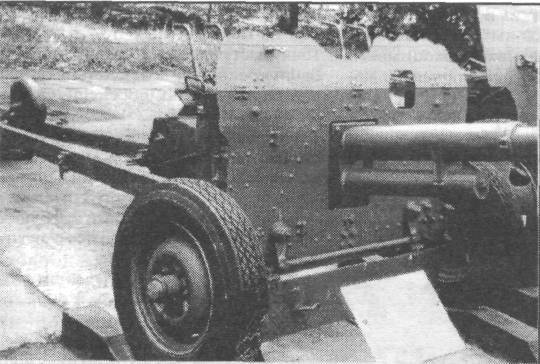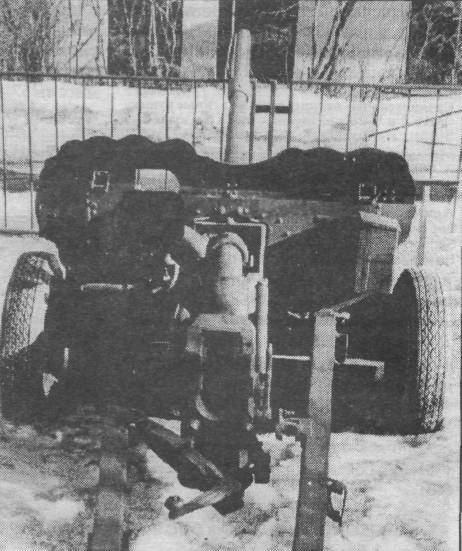Post-war anti-tank artillery. 57 mm anti-tank gun H-26
The barrel is a monoblock having a screwed breech. Muzzle brake high power on the length of millimeters 1150 had 34 window. The brake, which is screwed on the trunk, is a continuation of its threaded part. Vertical wedge valve has mechanical semi-automatic.
When creating a mast, the German 75 / 55-millimeter anti-tank gun PAK.41 was taken as a model. The bearing shield played the role of the lower gun carriage on which all the gun assemblies were mounted. Upper machine - hemispheric mass, reinforced in the middle of the shield. The role of the recoil devices was played by the spring-operated knurling and hydraulic recoil brake. Swivel and lifting mechanisms screw. Beds are sliding, box-section, welded, attached to the shield.


The shielded carrier shield consisted of a pair of 3- and 4-millimeter sheets.
Suspension had coil springs. Several lightweight regular wheels from GAZ-A tires GK.
For direct fire, the OP1-2 sight is used.
A prototype of the X-26 in July-September of the 47 of the year passed the ground tests along with the M57-16 X-mm cannon on the main artillery ground. The test commission gave preference to the H-2 gun and recommended it after eliminating the design flaws to the military tests.
Plant No. 235 in August 48 of the year passed the 5-th W-26 for military tests, two swinging parts and one gun for OKBL-46. These guns were made according to the drawings corrected after carrying out field testing. The mass of the gun increased to 825 kg.
Plant No. 235 in April 1950 produced X-NUMX H-20 cannons for military trials. These guns were sent to the White Sea, Belorussian, Turkestan, Trans-Baikal and Trans-Caucasian military districts, and two guns from the first series were sent to the airborne army. In all VO military tests were carried out in the period from May 26 to September 25 of 1, except for the Trans-Baikal where they ended on February 50 of the 1 year. During military tests revealed the flaws of the trunk, as well as the weakness of the wheels M-51. The Commission considered that the gun X-20 withstood military tests and was recommended for adoption.
Plant number 106 in 1951 year made a series consisting of 100 anti-tank guns H-26.
Specifications of a prototype 57-millimeter anti-tank gun H-26:
Caliber - 57 mm;
Barrel length with muzzle brake - 4584 mm / 80,4 klb;
The length of the threaded part - 3244 mm;
The number of grooves - 24;
The depth of the rifling - 0,9 mm;
Cutting width - 4,65 mm;
Field width - 2,8 mm;
The angle of vertical guidance is from -8 ° to + 18 °;
The angle of horizontal guidance - 57 °;
The height of the line of fire - 733 mm;
The length in the stowed position - 6620 mm;
Width in the stowed position - 1775 mm;
Height in the stowed position - 1145 mm;
Stroke width - 1520 mm;
The mass of the system in the combat position - 799 kg;
Rate of Fire - 25 — 30 shots per minute;
The speed of carriage on the highway - 50 — 60 km / h.
Information